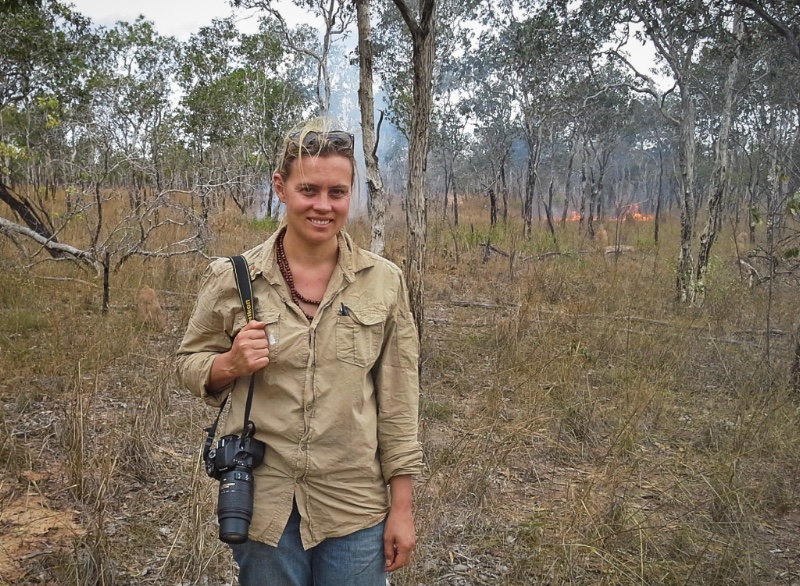Ecologist Michelle McKemey’s interest in Indigenous land management has been something of a slow burn. It crackled to life during a family trip around Australia, when she was just 11, but wasn’t rekindled until years later, during her Honours study of how Aboriginal people manage feral animals in the Arafura Wetlands of Arnhem Land.
“As part of my thesis I was choppered in to this remote place that not many white people had ever visited, to do flora and fauna surveys,” Michelle said. “I remember being struck by the amazing knowledge held by the Traditional Owners – people who had never left their country – and how much I could learn from their connection with the landscape. It changed my whole notion of ecology.”
This deep respect for the First Australians and their vast knowledge base can now best be described as a raging wildfire – figuratively and literally – as the University of New England (UNE) student tackles her PhD. At Wattleridge, the first Indigenous Protected Area declared in NSW, near Guyra, Michelle’s collaborating with people of the Banbai Nation to monitor the ecological and cultural changes that occur when fire is reintroduced to the landscape.
Unlike swathes of northern Australia, where Aboriginal land tenure and traditional burning is well established, to the south many Aboriginal groups are looking to return to their country and revive burning practices. The Banbai rangers are working with the Rural Fire Service and Firesticks Alliance to reignite their fire management, and partnering with Michelle to monitor bushland and animal behaviour before and after different types of fires.
Research from Australia’s north has revealed that re-introducing Aboriginal burning practices can have significant benefits. It reduces the prospect of periodic wildfires, enhances biodiversity, increases the resilience of the landscape, and substantially reduces carbon emissions. “Beyond the ecological effects, it also brings Aboriginal people back onto their land to manage it,” Michelle said.
At Wattleridge, she and the Banbai rangers are studying how traditional, low-intensity mosaic burning compares to higher-intensity fires, using two species – the threatened black grevillea and culturally significant short-beaked echidna – as bio-indicators. It’s the first university-based monitoring of contemporary cultural burning in southern Australia.
“It’s applied science that we hope will inform future fire and co-operative land management,” Michelle said. “With the extent of Aboriginal land expanding across Australia, this model could be adopted elsewhere. We’ve had considerable interest from other Indigenous communities in our work and the fire and seasonal calendars we have developed, which are additional tools that can be used for the revitalisation of culture and language.”
It’s a big undertaking for the busy mother of two small children, who also runs an environmental consultancy and, with her husband, a superfine Merino, prime lamb and cattle grazing enterprise.
“People advised me against doing my PhD, but I did it anyway,” says Michelle. “It’s a mountain I have to climb and I’m allowing six years to complete. It’s really hard work, but it benefits me every day, even in my own business.
“I am trained as a scientist and science is based on observations. But Aboriginal knowledge is built on observations stretching back 65,000 years and these observations can contribute substantially to western science. Some of the most incredible moments of my life have been out on country with elders.”
There are cultural sensitivities and challenges to this work, but it’s now impossible to extinguish Michelle’s enthusiasm. “I am interested in how Aboriginal people and scientists can work together to manage the landscape in the best way possible,” she said. “Protecting our environment and the world’s oldest living culture is one of the reasons I get out of bed in the morning.”
Michelle gratefully acknowledges the support of the Firesticks project, Banbai Enterprise Development Aboriginal Corporation, Rural Fire Service Association and Northern Tablelands Local Land Services (through Australian Government National Landcare Program).
Early findings: Michelle and her Banbai collaborators have found that a single, larger, hotter hazard reduction burn in neighbouring Warra National Park had more of an impact on echidnas than the smaller, patchier burns on Wattleridge. Bigger fires promote ant activity, encouraging echidnas, but the echidnas move quickly through areas without protective cover, probably to avoid predation by foxes. The smaller, lower-intensity burns retain echidna protection such as hollow logs. As far as the grevilleas go, the lower intensity burns create a multi-age population of plants, whereas the hotter fires appear to destroy more mature, seed-bearing plants.


